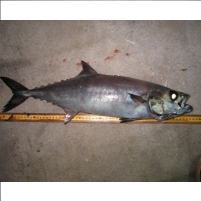Think You’re Eating White Tuna Because the Menu Says So? Think Again
Wednesday, October 26, 2011
 Escolar (photo: NOAA)
Escolar (photo: NOAA)
Consumers in Massachusetts have been getting duped by unscrupulous restaurateurs and fish suppliers who have routinely used cheaper species in place of what was actually ordered, according to a five-month investigation by The Boston Globe.
Testing conducted on behalf of the newspaper revealed that 48% of 183 fish samples collected at restaurants and supermarkets were not the species ordered.
For example, at one restaurant, the $23 flounder fillet turned out to be swai, a Vietnamese catfish that goes for less than $4 a pound.
Of the 26 samples represented as red snapper, 24 were a different fish; of the 23 samples sold as white tuna, not one was really white tuna. More often than not it was actually escolar, “an oily, cheaper species banned in Japan because it can make people sick.” It can produce a type of oily diarrhea known as keriorrhoea.
The newspaper reported that sometimes the switcheroo by restaurants was unintentional, the result of mislabeling by producers and distributors. But often it was deliberate in an effort to boost profits.
Weak government oversight, industry indifference and consumer ignorance were blamed for allowing the mislabeling to happen so much of the time.
-Noel Brinkerhoff, David Wallechinsky
On the Menu, But Not on Your Plate (by Jenn Abelson and Beth Daley, Boston Globe)
From Sea to Sushi Bar, a System Open to Abuse (by Beth Daley and Jenn Abelson, Boston Globe)
FDA Inspects Only 2% of Imported Food (by Noel Brinkerhoff, AllGov)
Escolar: The World's Most Dangerous Fish (by Pablo Escolar, Medellitin)
- Top Stories
- Unusual News
- Where is the Money Going?
- Controversies
- U.S. and the World
- Appointments and Resignations
- Latest News
- Musk and Trump Fire Members of Congress
- Trump Calls for Violent Street Demonstrations Against Himself
- Trump Changes Name of Republican Party
- The 2024 Election By the Numbers
- Bashar al-Assad—The Fall of a Rabid AntiSemite






Comments